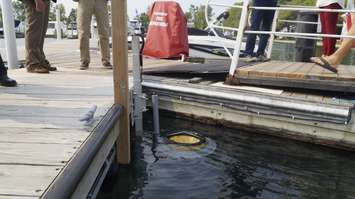A floating trash can installed in the St. Clair River at Sarnia Bay Marina is part of a wider effort to clean up the Great Lakes.
The Great Lakes Plastic Cleanup project involves two innovative projects targeting plastic litter in the Great Lakes and the loss of valuable materials to landfills in Ontario.
NOVA Chemicals is making a $200,000 commitment to become the lead corporate sponsor of the project.
Council of the Great Lakes President and CEO Mark Fisher said the funding will help with the installation of 25 Seabin skimmers in system waterways by season's end.
 Mark Fisher, President and CEO, Council of the Great Lakes Region, at Sarnia Bay Marina. 16 September 2020. (BlackburnNews.com by Colin Gowdy)
Mark Fisher, President and CEO, Council of the Great Lakes Region, at Sarnia Bay Marina. 16 September 2020. (BlackburnNews.com by Colin Gowdy)
"It draws in water through a pump mechanism and it collects floating debris which marinas check on a daily basis," said Fisher. "They'll take it out, they'll do some waste characterization to figure out what is coming in, whether it's plastic straws or plastic bottles, and they'll upload that analysis every day and it will give us a snapshot right across the Great Lakes about what kind of plastics we're finding from microplastics to large plastics."
He said the Seabin at Sarnia Bay Marina can pull out a lot of trash on a daily basis, depending on where it's located.
"Obviously we see some material that's already been captured by the device -- it's been in here for less than a day -- so we'll test that over time. The great thing about this device as well is that you can move it strategically, so if there's another part of the marina where you notice more debris accumulating, you can move it to those spots."
Fisher said the Great Lakes project also includes installing LittaTraps.
"It's a trap that goes into a catch basin, and obviously we're trying to stop overland flow of materials and plastics before they actually get into the environment through parking lots and other means."
Fisher said there's a big problem with plastics finding their way into the Great Lakes.
"Right now, we've got about 20 million tons of plastics finding their way into the Great Lakes every year. Eighty per cent of the material showing up on Great Lakes shorelines we have found to be plastic, so we know that we've got an emerging plastics problem in the Great Lakes. We don't understand all of the pathways, but we certainly know that we need to do a better job around engaging consumers again about reduce, reuse, recycle."
Fisher said the project will help us understand the plastic pollution problem in the Great Lakes, but more importantly, the pathways and how we stop plastics from entering the environment, adding, we need to create a more circular economy and stop the take, make, dispose kind of model.


https://twitter.com/GLPCleanup/status/1306279582094553090